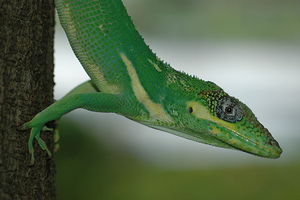Cuban Anole
| This article has been peer reviewed but is awaiting expert review. If you would like to help with this, please see more information about expert reviewing. |
Scientific name: Anolis equestris
- Other common names: Knight anole
Description
This is one of the largest anoles and is much more heavily built than most species. Large males can reach a total length of 50 cm and display a range of colours. They may be brown and white, or green, and well-marked specimens often have areas of blue on the head. The dewlap is generally white or pale blue. Males will grow to a larger size than females and their heads, particularly in older males, is significantly more massive. Hemipenile bulges at the base of the tail may help with sexing. Knight anoles are impressive, display well and thrive in vivariums. They are however capable of inflicting a nasty bite and should not be kept with green anoles or any smaller lizard.
Range
Cuba, SE North America (introduced).
Diet
For hatchlings, follow the diet given for adult green anoles. Adult Cuban anoles will feed on adult crickets, king mealworms, and pink mice. They have been observed feeding on plant matter in captivity. Insect food should be nutrient loaded and dusted with supplement.
Enclosure
The care of Cuban anoles in captivity is similar to green anoles, but they require more space. The minimum size enclosure would be a 130 litre aquarium with screen top. For a group (they are best kept in groups of one male to one or more females), at least a 250 litre vivarium is recommended. Add thicker branches both diagonally and vertically. Use larger plants such as philodendron (Monsteria spp.) and fig (Ficus spp). Dracaena can be planted sideways to provide room for climbing.
Temperature
Daytime temperatures in the vivarium should be 23-29ºC. The temperature at basking sites should be up to 34ºC. At night, the temperature can drop to 18ºC. For tropical anoles the temperature should not drop below 22ºC.
Literature Search
Use these links to find recent scientific publications via CAB Abstracts (log in required unless accessing from a subscribing organisation).
Cuban Anole (Anolis equestris) publications

